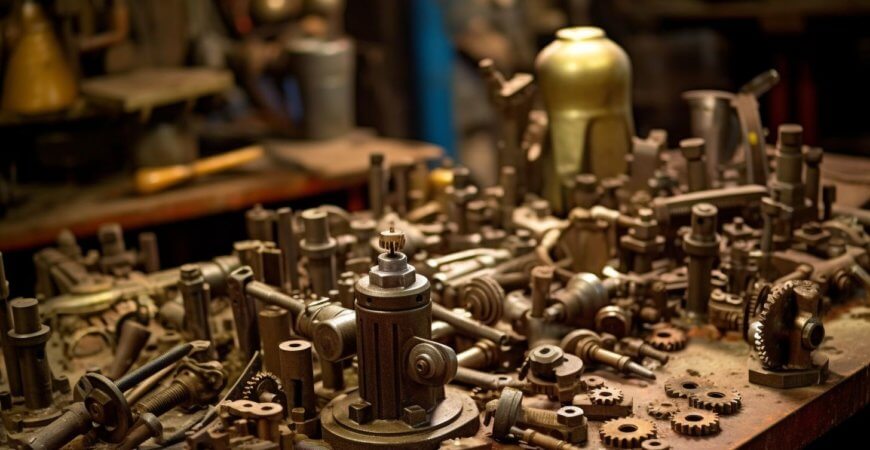

What is the Difference Between Brass and Bronze?
Brass and bronze are two of the most commonly used metal alloys in the world, both having a variety of key uses that make them integral to various sectors of our economy. These alloys have been used for centuries in a wide range of applications, from musical instruments to architectural accents. The similarities don’t end there, however.
Brass and bronze are both copper-based alloys, and this fact has often prompted people to ask “What is the difference between brass and bronze?”, but the reality is, despite their many similarities, bronze and brass possess distinct properties and characteristics that make these two alloys quite different in key areas. And in this article, we’ll answer this question in depth by going over all the key differences between these two widely-used alloys.
Composition
Although both alloys are copper-based, the composition of each one is different:
- Brass is an alloy made primarily of copper and zinc. The ratio of copper to zinc can vary, resulting in different types of brass with varying properties.
- A bronze alloy is primarily composed of copper, but it can also contain other elements such as tin, aluminium, nickel, or zinc. The addition of these elements gives bronze its distinct properties that set it apart from brass and other alloys.
Colour
By simply holding the two types of alloys, one of the most striking differences you’ll immediately notice is the colour difference:
- Brass typically has a yellowish-gold hue, similar to that of pure copper. This colour can vary depending on the exact composition of the metal alloy.
- Bronze alloys tend to have a reddish-brown or tan colour, which can range from light to dark, depending on the specific formulation.
Physical Properties
Since they have different compositions, it is to be expected that bronze and brass would have different physical properties as well.
- Brass is generally known for its malleability, it can be easily shaped and formed. It also has relatively low strength and hardness compared to bronze.
- Bronze, on the other hand, is much stronger and harder than brass, making it suitable for applications that require greater toughness and durability. Bronze can also have a low melting point, comparatively speaking, depending on its composition.
Corrosion Resistance
Another significant difference between brass and bronze lies in their resistance to corrosion. Brass is more susceptible to corrosion than bronze due to its higher zinc content. It can tarnish and develop a patina over time when exposed to air, moisture, and certain chemicals. In contrast, bronze has better corrosion resistance, making it suitable for environments where it gets in contact with humidity and water like the outdoors and submerged bearings.
Do you want to recycle scrap metal?
Contact us! +44 (0) 79 313 61034
Application
Although there is some overlap between the uses of bronze and brass, due to their different composition and physical properties, they have different applications. And in fact, this is the most important and relevant difference between brass and bronze, and that’s why we’ll explore it in more depth.
Brass Applications:
- Musical Instruments: Brass instruments such as trumpets, trombones, and saxophones are typically made of brass due to their malleability, allowing for complex shapes and precise tuning.
- Plumbing Fittings: Brass fittings are commonly used in plumbing systems due to their corrosion-resistant nature and ease of installation.
- Decorative Items: Brass alloys’ warm golden colour and aesthetic appeal make it a popular choice for decorative items like lamps, door handles, and fixtures.
- Electrical Connectors: Brass’s excellent electrical conductivity and ability to withstand corrosion make it suitable for electrical connectors and terminals.
Bronze Applications:
- Heavy Machinery Parts: Bronze is used in the manufacturing of gears, valves, and other components in heavy machinery that require high strength and durability.
- Sculptures and Artwork: Bronze has been used for centuries in sculpture due to its durability, ability to hold intricate details and the characteristic patina it develops over time.
- Architectural Accents: Bronze is often used for architectural details, such as door handles, plaques, and decorative panels, due to its durability and aesthetic appeal.
- Bearings and Bushings: Bronze’s superior strength, hardness, and self-lubricating properties make it an excellent choice for bearings and bushings in heavy machinery and equipment.
Summary
As two of the most commonly used alloys in the world, questions about the difference between bronze and brass are asked quite regularly, and although they have some similarities, they also have key differences that you need to understand if you want to make use of these alloys. In this article, we went over some of the biggest differences between the two.
